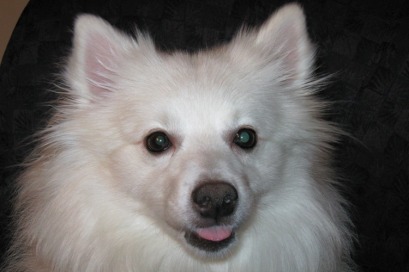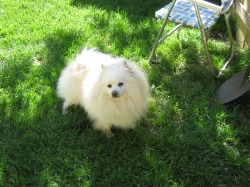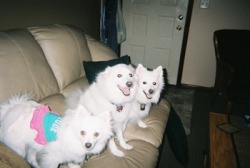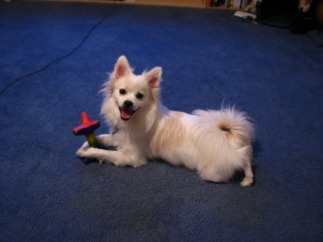All About Eskies
Your Eskie WILL:
- Bark
- American Eskimo Dogs bark. They bark at leaves, they bark at trees. Eskies bark at friends, Eskies bark at strangers. Whether adopted from a shelter or rescue, or having lived with you from 8 weeks of age, American Eskimos bark, loud and long. It is important for you to understand why your dog is barking, and how to control it. If you have sensitive ears or live in a busy, noisy apartment... an American Eskimo dog is not for you.
- American Eskimo Dogs bark. They bark at leaves, they bark at trees. Eskies bark at friends, Eskies bark at strangers. Whether adopted from a shelter or rescue, or having lived with you from 8 weeks of age, American Eskimos bark, loud and long. It is important for you to understand why your dog is barking, and how to control it. If you have sensitive ears or live in a busy, noisy apartment... an American Eskimo dog is not for you.
- Shed
- If you enjoy immaculate black pants, an Eskie might not be for you. Most American Eskimo dogs shed year long, and require a lot of brushing when blowing coat. They shed on everything they touch, and even some things they don't. If dog hair is unsightly in your opinion, or you have dog allergies, an American Eskimo dog is not for you.
- Require INTENSE socialization
- Whether an 8 year old rescue dog or a 8 week old puppy, your Eskie will need to constantly be introduced to new people. This means daily visits with new, trust worthy people who also understand that Eskies are naturally suspicious. American Eskimo dogs who are not socialized with many people, children, dogs, and non-canine pets can develop "shy-sharpness," which is also called fear aggression. If you, or a child, or a guest, backs a frightened Eskie into a corner, they are not afraid to bite. When Eskies come to private rescues, or are born to good breeders, they start the socialization process. Shelters do not, and bad breeders don't even know how. It's up to you and your family to continue this when your Eskie arrives home.
- Eskies are not Labradors. They are not the dog park darling, and oftentimes will not tolerate most dogs that they view as strange. If you want your dog to get along with other dogs, it is your responsibility to socialize your dog with many calm, stable dogs. Even then, your Eskie may never get along with other dogs without your close supervision.
- Your American Eskimo will love you and your family, as they tend to bond closely to their people. However, Eskies are not social butterflies, and may never accept strangers in your home. You will have to learn to manage this behavior with training and careful planning.
If you're still interested in an Eskie, there are Eskies interested in you!
Physical Description and Characteristics
A small to medium-size Nordic-type dog, the American Eskimo Dog is known for its bright white coat, jet black points (lips, nose and eye rims) and erect triangular ears. The breed’s white double coat consists of a short, dense undercoat, with longer guard hairs forming an outer coat that stands off from the body. Many Eskies have tones of biscuit cream or butter cream in their coats. The skin is pink or gray, and points are sometimes liver in color; however, liver points are considered a conformation fault. The toes and pads are either pink or black. The tail should curl easily over the back, and should not be overly long.
Temperament
Eskies are many things, but should be loving, hardy dogs who are always ready and willing to play. The puppyhood of the American Eskimo dog lasts about two years, with high energy and need for intense socialization. They bond closely to their family, and almost always love children.
The Eskie is assertive and brave. Ever ready to pop its head into new situations, the Eskie will rarely back down from an adventure. They will sound a high pitched alarm bark to notify the family of intruders and visitors, and must be socialized with new people early and often throughout their life in order to avoid shyness or sharpness.
Eskies must be given plenty of training, as they are extremely intelligent and have a drive to work and accomplish tasks that is fairly uncommon in "companion only" dogs.
The Eskie is assertive and brave. Ever ready to pop its head into new situations, the Eskie will rarely back down from an adventure. They will sound a high pitched alarm bark to notify the family of intruders and visitors, and must be socialized with new people early and often throughout their life in order to avoid shyness or sharpness.
Eskies must be given plenty of training, as they are extremely intelligent and have a drive to work and accomplish tasks that is fairly uncommon in "companion only" dogs.
Health Problems
The American Eskimo dog should be a naturally healthy dog with few genetic problems; however, poor breeding practices have increased the instances of hip dysplasia, progressive renal atrophy, luxating patella, and flea allergy.
Most American Eskimo dogs are prone to becoming obese, as well. Eskies should be fed a premium or grain-free premium kibble diet which is high in protein in appropriate amounts each day to avoid this life-shortening condition. Appropriate exercise must be offered (and for lazy Eskies - enforced!) daily in order to maintain healthy hearts and weights.
Most American Eskimo dogs are prone to becoming obese, as well. Eskies should be fed a premium or grain-free premium kibble diet which is high in protein in appropriate amounts each day to avoid this life-shortening condition. Appropriate exercise must be offered (and for lazy Eskies - enforced!) daily in order to maintain healthy hearts and weights.
Behavior Problems
Poor breeding choices have introduced many behavior problems into this stellar breed, and other problems are induced by lack of training, lack of exercise, or other environmental factors. These problems include:
Shyness: The American Eskimo Dog is naturally reserved with strangers. However, poor socialization can lead to a naturally submissive Eskie becoming fearful of new noises, people, and experiences. Shyness is always manageable, and can usually be overcome with enough patience and socialization effort.
Sharpness: The American Eskimo Dog is naturally an alert guard dog, but should never be aggressive or snappish toward strangers or visitors. However, lack of socialization can lead to an assertive dog becoming sharp with visitors through barking, snapping, and even biting. This is a manageable issue, and can be overcome with redirection and socialization.
Separation Anxiety: Most dogs occupy themselves while we are gone, either by chewing toys, sleeping, or just plain waiting for us to get back. Dogs with separation anxiety are unable to remain calm when their people are out of the house, or even out of sight, and exhibit many panic behaviors like self-harm, destroying household items, barking, and housesoiling. True separation anxiety cannot be overcome with training alone; crate training and desensitization to separation must be slowly begun and consistently practiced. However, once dogs with separation anxiety are able to overcome the issue, they remain wonderful pets!
Shyness: The American Eskimo Dog is naturally reserved with strangers. However, poor socialization can lead to a naturally submissive Eskie becoming fearful of new noises, people, and experiences. Shyness is always manageable, and can usually be overcome with enough patience and socialization effort.
Sharpness: The American Eskimo Dog is naturally an alert guard dog, but should never be aggressive or snappish toward strangers or visitors. However, lack of socialization can lead to an assertive dog becoming sharp with visitors through barking, snapping, and even biting. This is a manageable issue, and can be overcome with redirection and socialization.
Separation Anxiety: Most dogs occupy themselves while we are gone, either by chewing toys, sleeping, or just plain waiting for us to get back. Dogs with separation anxiety are unable to remain calm when their people are out of the house, or even out of sight, and exhibit many panic behaviors like self-harm, destroying household items, barking, and housesoiling. True separation anxiety cannot be overcome with training alone; crate training and desensitization to separation must be slowly begun and consistently practiced. However, once dogs with separation anxiety are able to overcome the issue, they remain wonderful pets!
All articles and information contained on this website are the sole property of Madonna Kilpatrick, not to be used without express permission (C) 2010. Some images are the property of Jim Guilliatt (C) 2010. Not for distribution without credit. To reuse any image or information contained herein, contact us prior to use for permission.




